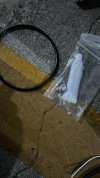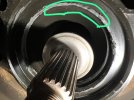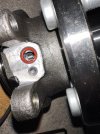Or just the single oring that comes with the kit will do just fine? I have just disassembled mine and noticed a lot of old RTV / Silicone in the axle where the hub fits. There was also not any sign of "red loctite" on the splines of the shaft.
Also, the wheel-hub kit came with some sort of grease - is that for the oring ? Or do I have to grease the inner part of the ABS sensor?
Appreciate any thoughts from the folks here.
Thanks!
Also, the wheel-hub kit came with some sort of grease - is that for the oring ? Or do I have to grease the inner part of the ABS sensor?
Appreciate any thoughts from the folks here.
Thanks!



